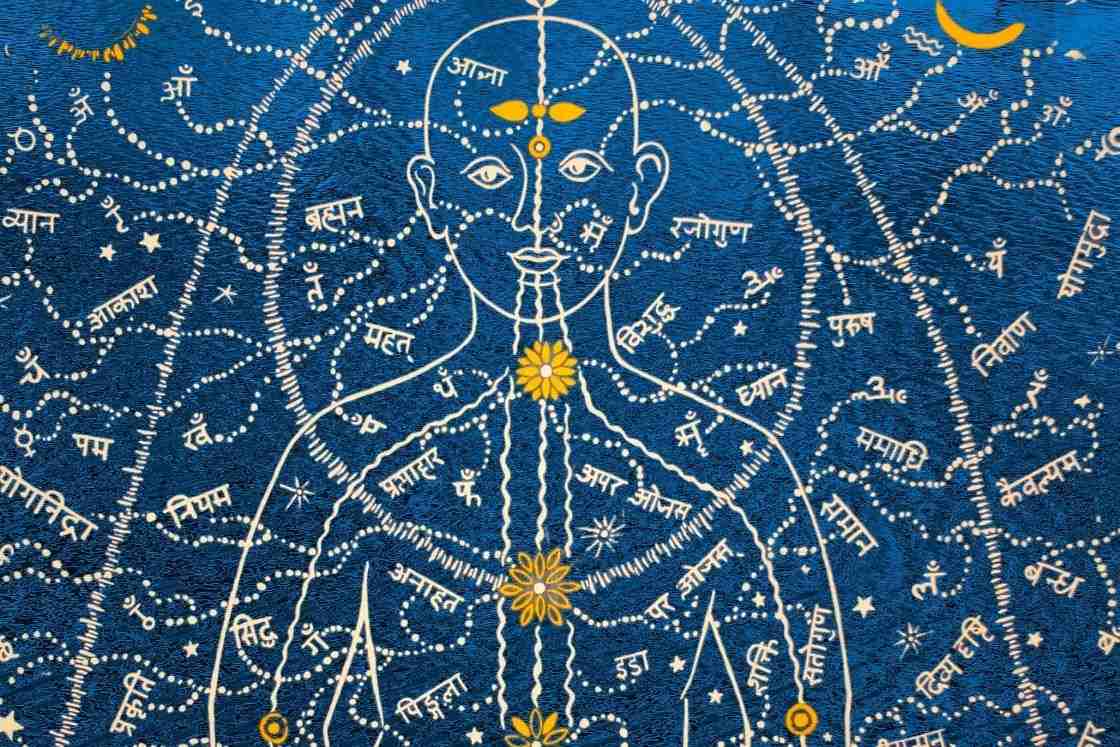
We know that the 72,000 Nadis in our body are responsible for conveying Prana (vital life force) to different parts of the body. However, due to impurities in some Nadis, not all of them are active in this process.
To carry Prana effectively and awaken the Kundalini, the Nadis first need to be activated and purified.
Ida and Pingala Nadis can be activated through voluntary breathing techniques.
- When we inhale and exhale only through the right nostril, it activates Pingala Nadi.
- Similarly, breathing through the left nostril activates Ida Nadi.
The awakening of Sushumna Nadi can only occur when there is a perfect balance between Ida and Pingala.
Unless this balance is achieved, the Sushumna remains closed, and the power of Kundalini stays dormant.
This balanced state is possible only when the smaller Nadis often referred to as Nadikas that branch from Ida and Pingala are purified through appropriate practices.
Purification of nadis

According to the Gheranda Samhita, Nadi Shuddhi Pranayama (purification of the energy channels) must be practised before engaging in advanced yoga techniques, especially Pranayama. When the Nadis (energy channels) are clogged with impurities, Prana Shakti (vital energy) cannot flow smoothly. This restricts the full benefits of breathwork and meditation.
Therefore, cleansing the Nadis is a crucial step before beginning any serious pranayama practice.
Two methods of nadi purification:
- Samanu – A mental process involving Bija Mantra (seed sound) repetition
- Nirmanu – A physical cleansing method through Shatkarmas like Dhauti kriya
Samanu: mental purification method
Samanu is a meditative technique to purify the Nadis using breath control and mantra chanting. Here’s how it is performed:
Performing Samanu Purification
Samanu is performed by sitting in Padmasana posture. Remembering the teacher, one should contemplate on Vayu Bija Mantra (yam यं) full of energy and of smoke color,
- Inhale through left nostril repeating the Vayu Bija Mantra for 16 times. This is called as Pooraka.
- Later the breath should be restrained for a period of 64 repetitions of the Mantra. This is called Kumbhaka.
- Exhalation of the breath should be done through the right nostril slowly by repeating the Bija Mantra for 32 times. This is called Rechaka.
The root of the navel is the seat of Agni tattva (fire element). Raising the fire from that place one has to join the Prithvi tattva (earth element) with it and has to contemplate on the mixed light.
- By repeating the Agni Bija Mantra (ram रं) for 16 times, inhalation should be done through the right nostril.
- Retention of breath is performed for 64 repetitions of the same Bija Mantra.
- Exhalation of breath is to be done through the left nostril with the repetition of Bija Mantra for 32 times.
Then one should fix the gaze on the tip of the nose and contemplate on luminous reflection of the moon while chanting the Bija mantra (Tham ठं).
- Inhalation through the left nostril repeating the Bija mantra (Tham ठं) for 16 times;
- later breath is to be retained by repeating the Bija Mantra for 64 times;
- Meanwhile one has to imagine or contemplate that the nectar flowing from the moon at the tip of the nose flows through all the Nadi and thus purifies them.
- Later exhalation of the breath is to be done through the right nostril contemplating on Prithvi bija mantra (lam लं) repeating for 32 times.
By these 3 Pranayamas, it is explained that Nadis get purified.
Hathayoga Pradeepika, a treatise on Hathayoga explains the sign of Nadi Shuddhi as follows;
The body becomes slender and bright, the person will be able to retain the breath for a longer duration, the gastric fire becomes more active, the inner sound can be heard from within and the individual can enjoy the perfect health.
If the process is not practiced in a proper method then it will end up in various disturbances in the Prana leading to many types of illnesses.
Nirmanu: physical nadi purification (shatkarma techniques)
While Samanu uses the power of mantra and breath, Nirmanu focuses on physical yogic cleansing practices, collectively known as Shatkarmas. These techniques are essential for removing toxins from the body and clearing blockages in the energy pathways.
Common Nirmanu (Shatkarma) Techniques:
- Dhauti – Cleansing of the digestive tract
- Basti – Yogic colon cleansing
- Neti – Nasal passage cleansing (often with a Neti pot)
- Nauli – Abdominal churning to massage internal organs
- Trataka – Focused gazing for cleansing the eyes and mind
- Kapalabhati – Rapid breathing for purifying the lungs and energizing the mind
Sushumna Nadi Awakening

The word Sushumna refers to a state of ultimate bliss a still, undisturbed mind rooted in deep awareness.
The awareness of self-breath is of primordial importance for the awakening of Sushumna. This state of blissful mind can be achieved only when the breath flows through both the nostrils undisturbed, balanced, and with ease.
Swami Rama School of meditation
Understanding the awakening process
- A person should be free of external attachments, the senses should be withdrawn to within self by detaching from their objects of perception.
- Then Ida Pingala and Sushumna Nadis should not be disturbed so one sits comfortably keeping the neck, head, and trunk straight.
- The steps involve concentrating on the bridge between the eyebrows (Bhrikuti) and perform Pranayama along with Jalandhara Bandha and meditate on the Chakras one by one starting from Mooladhara to Sahasrara Chakra along with chanting of Bija Mantras.
According to Swara Yoga, the first step of the awakening of Sushumna involves learning to change the flow of breath with our mental ability according to our wish without the fingers placed on the nose. This can be only achieved by regular practice of concentration and Sadhana for a certain duration.
Once the concentration of such level is achieved there will be a free flow of breath in both the nostrils evenly and it attains a state of bliss called Sukha mana, mind free of worries.
In this state, the practitioner can feel the sensation of fire as if a hot current of air is blown through the channels. The Chakras vibrate with Pranic energy, and the prime force gets awakened. Later on, by regular practice, this state will help in going further to the level of attaining the higher stages of self-awareness, knowledge of absolute truth and finally reaching salvation which is the ultimate purpose of Yoga.
Swami Satyananda Saraswathi explains even practicing of some specific Asanas stimulates the Chakras. For example;
- Chakrasana stimulates Manipura Chakra
- Sarvangasana for Vishuddhi Chakra
- Sirshasana for Sahasrara Chakra, etc.
Other Asanas regulate and purify the Nadis, facilitates the proper conduction of Prana throughout the body. Stimulated Chakras generates impulses that thereby awaken the Sushumna Nadi.
Caution
All these practices should be followed under the guidance of a renowned Guru.
Yoga prescribes strict dietary restrictions during such practices. Moderation in diet is advised, and skipping meals is discouraged. Only Sattvik Ahara (pure foods) should be consumed—such as ghee, milk, rice, barley, green gram, black gram, plantain, jackfruit, cucumber, and green leafy vegetables.
Rajasik and Tamasik foods those that are spicy, salty, pungent, fried, roasted, or fermented (such as curd, whey, and palm-based items)—should be avoided during the process of Nadi purification.





I heard Number of Nadis are 7200000 (72 Lakh) and not 72000. May be you know better.
if u dont hear, doesnt mean that truth can become false, its 72000 only Mr